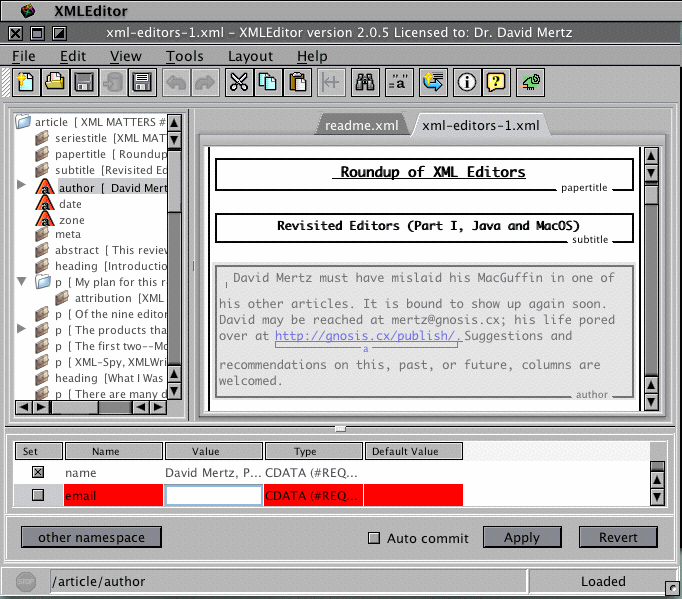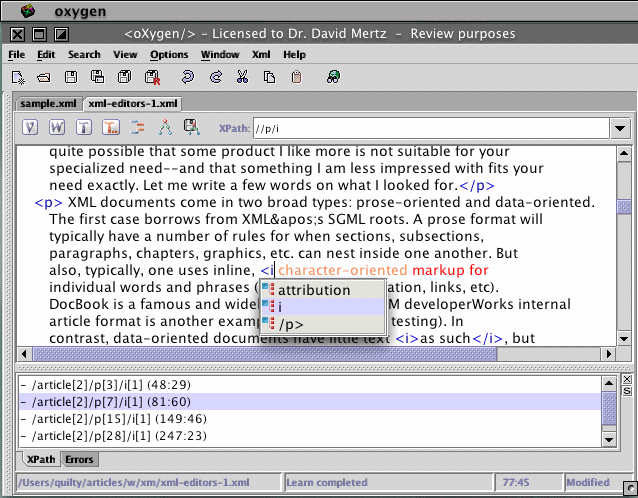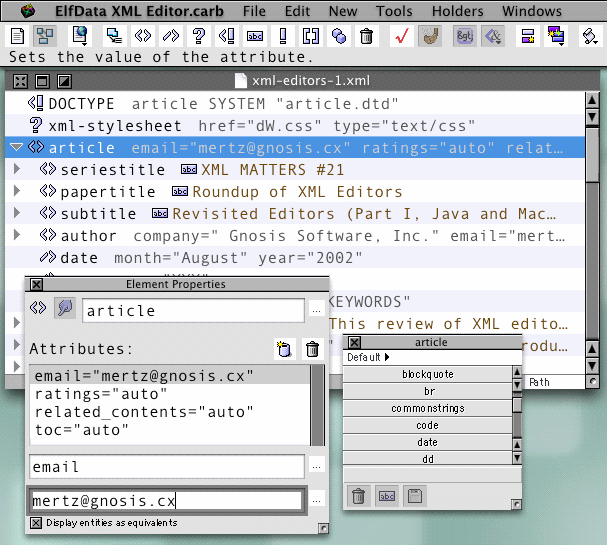
XML Matters #21: Roundup Of XML Editors
Revisited Editors (Part I, Java and MacOS)
David Mertz, Ph.D.
Transformer, Gnosis Software, Inc.
August 2002
This review of XML editors (and its followup) looks at the progress commercial tools have made in the year-and-a-half since I last looked at this category of tools. These tools have progressed from largely cosmetic wrappers around text editors to fleshed-out development enviroments that hugely ease working with XML-oriented technologies. This installment examines Java and MacOS applications.
Introduction
My plan for this roundup was to review nine commercial XML editors. This plan deliberately leaves out any discussion of general text editors--including both "everything including the kitchen sink" editors like (X)Emacs and more modest but customizable personal favorite text editors. But as XML Matters #6 remarked, the "zero case" of XML editing is using a plain text editor. A lot of text editors that are nominally "plain" have many language-specific customization, for XML and for other languages. Still, as you read this review, keep a question in the back of your mind: "Can my favorite programming editor do as well (or better)?" If the answer is "yes", you are set already.
Of the nine editors I had wanted to look at, I was unable to obtain three. The remaining six reviews are split over two installments to allow me to look in detail at the features of each product. This first part looks at the tools targetted at JVMs and MacOS--from my point-of-view, "programs I can run on my iBook." In researching products, I did not find anything Linux/Unix specific that was both current and of similar sophistication to those XML editors I review. Of course, the Java-based tools will run fine under Linux, as well as on other platforms.
The products that I do cover in this roundup are Morphon Technologies' Morphon 2.0.5, SyncRO's <oXygen/> 1.2.1, ElfData's XML Editor 1.14, Altova's XML-Spy 4.4, Wattle Software's XMLWriter, and NetBryx Technologies' EditML Pro 2.6.
The first two--Morphon and <oXygen/>--are Java-based applications that I tested on an iBook laptop running OSX 10.1.5 and the latest Apple HotSpot Java 1.3.1. I mention these specs to condition my impressions of responsiveness--UI performance has long been a weakness of Java applications. XML Editor was also tested on the same iBook, but it is a "native" MacOS application written in REALBasic. These products are discussed in this installment.
XML-Spy, XMLWriter and EditML Pro, all Win32 native applications. Details can be found in the next installment. These were obviously tested on a Windows machine--specifically, a Win98 laptop with a Pentium-II processor (366Mhz). None of the UI speed issues that I encountered during testing on the iBook applied to these products. Probably because of the difference between compiled and interpreted languages--not differences between OS's and CPUs--the Win32 applications were zippy and responsive, and no further comment on that aspect need be made.
What I Was Looking For
There are many different reasons someone might want an XML editor. It is quite possible that some product I like more is not suitable for your specialized need--and that something I am less impressed with fits your need exactly. Let me write a few words on what I looked for.
XML documents come in two broad types: prose-oriented and data-oriented. The first case borrows from XML's SGML roots. A prose format will typically have a number of rules for when sections, subsections, paragraphs, chapters, graphics, etc. can nest inside one another. But also, typically, one uses inline, character-oriented markup for individual words and phrases (bold, emphasis, citation, links, etc). DocBook is a famous and widely used example; IBM developerWorks internal article format is another example (I used both for testing). In contrast, data-oriented documents have little text as such, but rather contain nested table-like structures of numeric values and simple names. Data-oriented XML is often similar to RDBMS tables, and sometimes is generated from such databases. An ability to view XML as columns and rows is often important for data-oriented XML.
On top of the broad types, many special XML dialects have grown up. Many of these are data-oriented, such as SOAP, XML-RPC, WSDL, RDF, and so on. While all the XML editors reviewed can handle custom DTDs to some degree, particular needs might require more specific customization. Some of the same issue might apply to prose-oriented formats, particularly complex ones like DocBook, LegalXML, or TEI. Generally, an XML editor should make it significantly easier to create and modify valid XML documents conforming to the DTD or W3C XML Schema that you need to work with.
Personally, I tend to edit prose-oriented documents; I used IBM developerWorks conformant articles as test cases, and in most cases tried to play with something in the more complex DocBook format. In addition, I work on a lot of platforms, and am particularly interested right now in finding a set of tools to use on my new iBook (and its underlying Unix OS). Windows-only tools initially grab my attention less than cross-platform ones.
Morphon is a Java-based XML editor that focuses on a wordprocessor-like view of prose-oriented XML documents. In fitting with my preference, Morphon runs across a variety of platforms--anything with Java 1.1 or above (with Swing installed for older Java versions). I tested on the MacOSX iBook mentioned earlier.
Unfortunately, on a 500Mhz G3 with generous memory, Morphon still runs just slow enough that you cannot ignore Java's lack of UI responsiveness. It is usable--but you notice the issue. As a really minor matter, Morphon's look-and-feel options adapt somewhat less to the Mac UI than do some Java applications (like <oXygen/>), but only Mac-purists will care greatly about that one way or the other.
I looked at Morphon in its beta version, and it has progressed nicely in both features and stability. Unfortunately, it is still possible to arrive at an unstable/semi-frozen state when using Morphon. It never gets so bad that you cannot easily close and restart that application, but you will probably need to do so once in a while. As well, the CSS-Editor forces an awkward Z-order for some dialog/info boxes that need to be completely hidden or closed in order to use the main CSS-Editor window, rather than merely pushed backward. I suppose with a large enough screen you could work around this, but not on a laptop.
Morphon gives you several views on an XML document. Looking at the raw XML source code can only be done in preview mode (no changes). The main view is a wordprocessor-like screeen that utilizes CSS to configure the display. As I mentioned earlier, I think CSS is a better approach to display configuration than is XSLT or a custom format--that is what CSS was created for, after all. In addition to the wordprocessor-like view, Morphon gives you a "nested boxes" structural view. The idea here is that each element body is marked by either a labelled enclosing rectangle or by a labelled underscore. The fonts, colors, and the like are still determined by CSS, but the view does an extremely good job of displaying both the meaning (which typography emphasizes) and structure of a document at the same time. At the same time as the main view, you can optionally view a collapsible tree view, and use this to navigate the document. The tree can optionally display the first few words of each element body, which is also helpful.

By using strictly wordprocessor-like views, Morphon basically disables any capability for creating invalid XML documents in the first place. This is more seamless than applications that have a separate validation step and merely highlight problems. Context sensitive dialogs and menus point you to the insertions that are allowed at a given position. Morphon builds in an XSLT processor, and comes with some default XSLT definitions for converting DocBook to (X)HTML. You can easily use other DTDs and stylesheets.
Searching XML documents can be done with multiple regular expression variants (posix, sed, perl, etc), or plain text. You can search on text, attribute value, attribute name, or element name. However, unlike some tools, Morphon does not allow XPath searches, which seems like the most XML-oriented style. However, Morphon does display the XPath to the current cursor position.
Morphon costs $150 for a standard version, $75 for an academic license, and have various site licensing rates.
I really took a liking to <oXygen/> during this review. While in many ways, <oXygen/> is much less comprehensive than some other products, what is included is very well thought out and useful. Like Morphon, <oXygen/> is a Java-based XML editor that I tested on a 500Mhz iBook. You will need a more current version of Java, however, to run <oXygen/>--1.4 is recommended, 1.3 is required.
For whatever reason, using <oXygen/> did not have the sluggishness of Morphon--Java is still not blazingly fast, but working with the program is always comfortable. Some of the reason for the speed improvement is the fact that <oXygen/> as a much simpler display format--XML source rather than a wordprocessor-like view. But even on non-display issues like validation and XSLT/FO transformations, <oXygen/> is faster (and also in perfectly mundane stuff like pulling down menus and opening dialogs).
The <oXygen/> editor is stable and well-organized, but it is also best thought of as an enhanced text editor rather than a fully custom interface to XML editing. There is less to worry about with this more moderate goal. Within the simple interface, the bells-and-whistles are extremely helpful, however. Both the interface and the extras are clearly geared more towards programmers than towards document-creators or data-entry. You can preview (X)HTML output of transformed XML documents, and can prettify XML formatting--but basically, you can only edit syntax highlighted XML text.

One thing I really like about <oXygen/> is its "code insight" features. Most of the tools I looked at have some context sensitive prompting for tag/attribute entry; <oXygen/> has the best of these. When you type an opening angle bracket, a list of allowable tags pops up right below the cursor, and the highlight moves based on partial name completion; required attributes are included when the tag is completed. Included in the choices are the open tags that are eligible to be closed at the cursor position. For the best results, "code insight" will utilize a DTD or XML Schema--but if one is not available, <oXygen/> can generate a guess about the document structure based on the XML itself. If you like, you can save this inferred structure as a DTD.
Another nice touch is the included XSLT stylesheets for DocBook and XHTML. In addition to standard XSLT transformations, <oXygen/> has a built-in FO processor. This lets you create print-ready PDF or PS documents out of XML documents. The only other reviewed tool that has this capability is XML-Spy, but XML-Spy required the download of extra tools, and I could not get it working during my testing. <oXygen/> produced attractive PDFs with no special effort.
The search facility of <oXygen/> is unique, and clever, also. Basic text search (case in/sensitive, whole word, in tags, etc) is pretty standard. And regular expression searching is notable in its absence. What sets <oXygen/> apart is its XPath search facility. Some other tools allow composition of XPaths, but <oXygen/> displays a list of all matches in a pane, and uses the match list to navigate and highlight portions of the document. This is really useful, and very much in the spirit of XML.
A single user copy of <oXygen/> costs a moderate $65; the student version is $25; site licensing is available.
XML Writer is a MacOS native application (for MacOS 8/9/X) that is written in REALBasic. My understanding is that REALBasic is has recently been ported to Windows, or that the port is underway. So perhaps ElfData will decide to port to that platform also.
I do not know too much about the REALBasic language, but my impression is that it uses some sort of interpreted or byte-code environment to run application. In any case, the resulting speed feels similar to that of Java. XML Writer is comparable to <oXygen/> in this respect: fast enough to work with comfortably, but clearly slower than native compiled applications.
The two views of an XML document that XML Editor provides are an XML source view and an "enhanced tree view." The first is just what you would expect--syntax highlighting in a text editor. The XML source view is similar to <oXygen/>, but without the option for prettifying the source with structured indentation. The default view in XML Editor, however, is the enhanced tree view, which is similar to the tree pane in Morphon. The XML document, in tree view, is presented in the style of MacOS Finder "list view." Each line lists an element, comment, declaration or processing instruction with an icon on the left to identify the type of node. Elements that contain child nodes can be expanded and collapsed; each line also contains as much info on the element attributes or body as will fit. One aesthetic feature of XML Editor improves usability quite a bit: every other line is shaded in light gray (like a ruled paper), which helps orient your eye while navigating.

In addition to the main view window, XML Editor can optionally display some context sensitive dialog windows. I would prefer a paned interface to the floating dialogs, but this style is fine. One floating dialog displays either the attributes or body text of the currently selected item (depending on which is selected). You edit the attributes or text in this dialog. Another optional floating dialog is a "holder," which is a list of tags that can be inserted. A holder can be generated from a DTD or edited manually--but it is not context sensitive to limit insertions to currently valid elements. Insertions using the holder maintain well-formedness, but not necessarily validity.
XML Editor has several validation options. You can validate "on change" or "under mouse," as well as globally, by selection or in batch mode for multiple documents. But validation is always "after the fact" rather than directing editing actions. On the plus side, XML Editor uses a "fast" validation mode by default (with a "strict" option)--the result is that validation is far faster in XML Editor than in other products I have looked at (including with command-line tools I have worked with in the past). In some borderline cases, the fast validation might not handle some parametric entity declaration subtleties correctly, but I did not encounter any such issues during testing.
On the downside, XML Editor lacks any transformation capabilities--no XSLT or CSS display other than a crude "browser preview" option, and certainly no FO processing. The search capability of XML Editor is fairly rudimentary also; you can search for text in elements, attributes, bodies, etc--and can accumulate a list of search results. But there is no regular expression support, and no XPath support.
A single user copy of XML Editor will cost you $55.
Resources
Pixware's XMLmind XML Editor (XXE) appears to be a Java-based editor that uses CSS to configure a wordprocessor-like display (which I think is the right approach, although not the approach used by most products). However, I failed to get a response from the company, and I must confess that I find XXE's "commercial but only available in milestone versions" status confusing. I am not quite sure if this is a shipping product or just a good idea for a product--the screenshots and descriptions look promising though.
http://www.xmlmind.com/xmleditor/
Vervet Logic's XML Pro looks to be forgotten rather than not-yet-born. Based only on their webpages, XML Pro appears to be a Java-based editor that focuses on data-oriented XML documents. The company did not respond to requests, and their webpages appear not to have been updated in a few years (for example, compatible Windows versions are said to include 95, 98 and NT4.0--no mention is made of the various ME, 2000, and XP variants, either as compatible or not).
http://www.vervet.com/
Morphon Technologies' home page is:
http://www.morphon.com/
Read about SyncRO <oXygen/> at:
http://oxygen.sync.ro/index.html
Information on ElfData and XML Editor can be found at:
http://www.elfdata.com/xmleditor/
About The Author
David Mertz must have mislaid his MacGuffin in one of his
other articles. It is bound to show up again soon. David may
be reached at [email protected]; his life pored over at
http://gnosis.cx/publish/. Suggestions and recommendations on
this, past, or future, columns are welcomed.